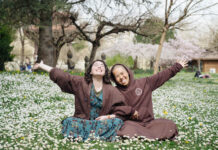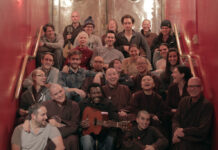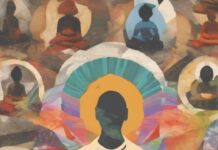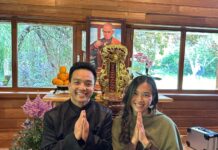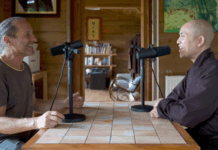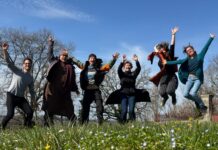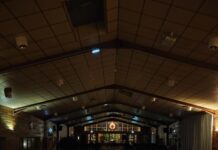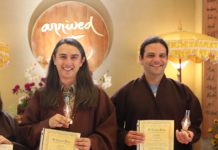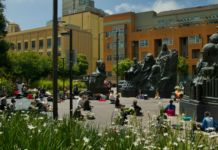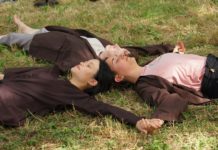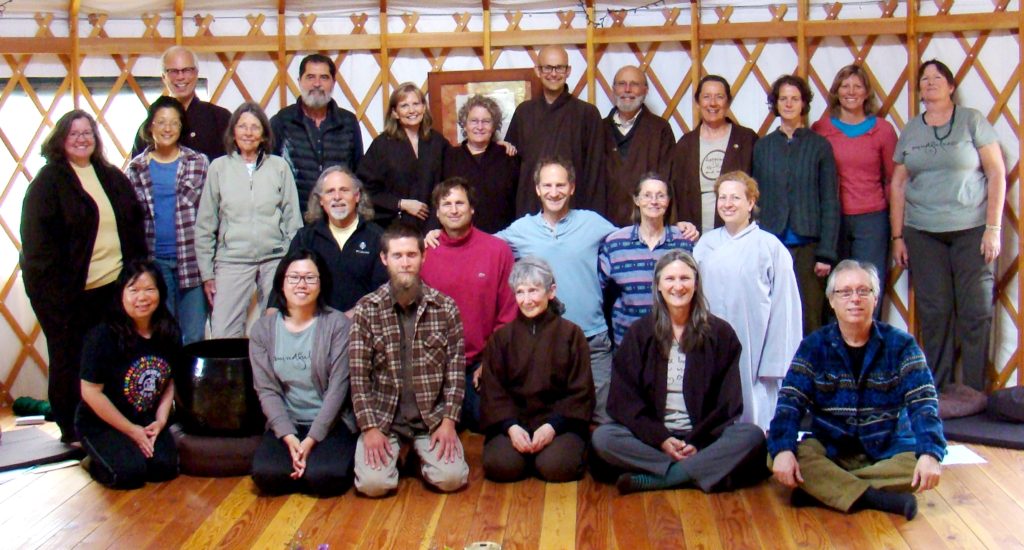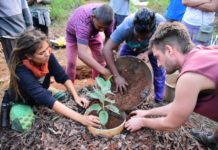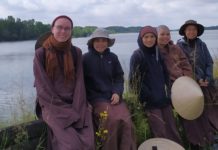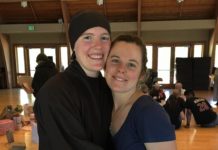An Interview with Brother Chan Phap Ho
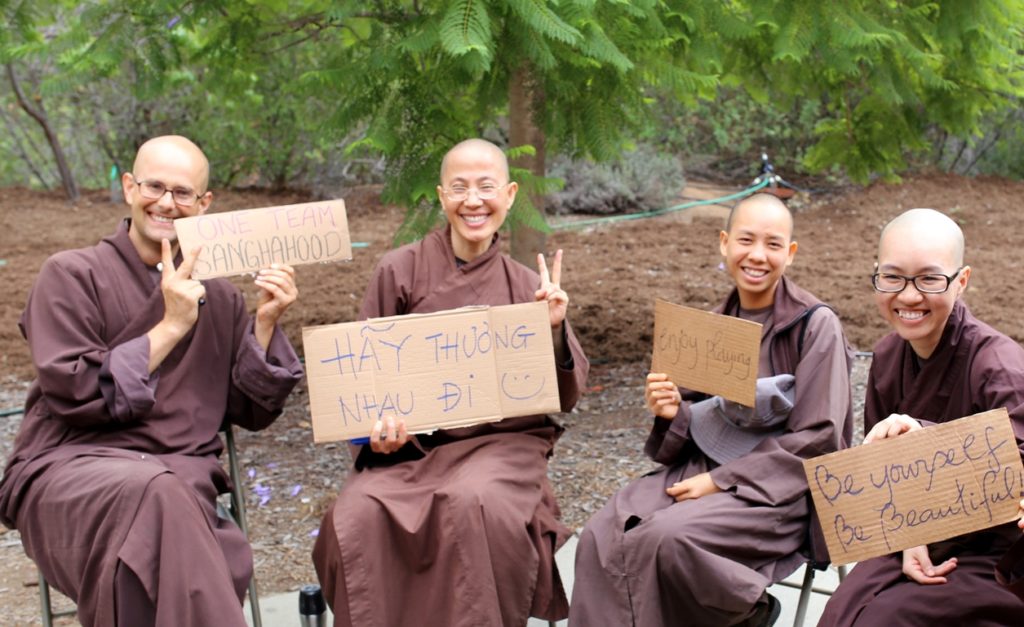
Brother Chan Phap Ho was born and raised in Stockholm, Sweden. At the age of twenty-nine, he left Sweden for India. That pilgrimage brought him to Plum Village, where he joined the monastics in 2003. In 2015, he returned to Plum Village for the winter retreat after ten years living and practicing at the Deer Park Monastery. Since 2010, he has been the Acting Abbott at Deer Park.
Question: In 2009, Thay shared with the Sangha a letter you wrote to Thay. In the letter, you shared that you are not only riding the Sangha boat, but you are also that very boat. Therefore, even if the boat is sinking, you will not think about jumping off the ship. Usually we write to Thay after overcoming a difficulty. What is the story behind the insight of the boat?
Brother Phap Ho: First of all, this may be an insight. However, Thay always teaches that such insights need to be maintained continuously as a concentration. To put it in another way, we need to live with the insights that we discover. This is very difficult, but if we can do this, our lives will radiate that insight.
The love for the Sangha is one aspect that protects and maintains my monkhood.
Since joining the monastics, I’ve had a very clear aspiration. From the bottom of my heart, I know that I want to live here, that I need to live here. However, that aspiration doesn’t stop doubts and confusion from arising when I encounter obstacles. Before, whenever a monastic disrobes, I usually wonder what will happen if I leave too. Then I realize I need to nourish and strengthen my commitment to the Sangha. This means I need to grow my love for the Sangha, for my brothers and sisters, and develop a healthy “attachment” so that when doubts or difficulties arise, I will not leave readily because I love my brothers and sister too much. The love for the Sangha is one aspect that protects and maintains my monkhood. This is a concrete practice that I strive to maintain.
A second concrete practice I conveyed to Thay was that if I have doubts and want to leave the Sangha, I will not leave right away. To the contrary, I resolve to stay for another year with the Sangha to look deeply at the difficulties and know for sure that leaving is really what I want. These practices and experience have given me the insight about the Sangha that I shared with Thay.
Question: Do you think that your responsibility as the Abbott at the Deer Park Monastery helps you have the deep insight that everyone of us is an element creating the Sangha boat? Please elaborate on this insight.
Brother Phap Ho: During the 2010 Asia tour in Malaysia, Brother Phap Dung asked me if I was open to taking over the executive Abbott role while he spent three months at Plum Village. I said: “Yes, I’ll try.” I asked him if he had any tips for me. He told me that I just needed to be a sheet of blank paper. Brother Phap Dung knows me well, so he knows what I need to practice while taking on this responsibility. I had a chance of working closely with him for several years, so I could observe and learn a lot on how he took care of the Sangha, even though he and I have very different personalities.
During the North American tour in 2011 and 2013, Thay confirmed that I was the Acting Abbott of the Deer Park Monastery. I have maintained that role since. To be honest, I took that responsibility first and foremost because I saw it as a challenge for me to serve and support the Sangha, a practice for me to continue my personal transformation as well. In his Joyfully Together book, Thay teaches that the role of an Abbott is to be present for everyone, to discover the talent and beauty of every individual of the Sangha, and to help nourish those beauties. That responsibility seemed difficult, but I was inspired to try.
I think that keeping a friendly attitude to be able to work and play with all the monastics and avoid being close to only a few people in the community is a very important practice. I usually try to seek out different brothers and sisters for help on different projects. Different members of the Sangha have different expectations of the Abbott, therefore my practice and service is very dynamic, which often poses itself as a challenge for me.
This position helps me to be more mindful of my perfectionistic tendency. At the same time, the position also trains me to spend enough time to listen to and communicate with my brothers and sisters, to spend enough time to look deeply into what is happening. There is so much for me to learn. However, all of the practice can be traced back to being mindful of the present moment.
Out of curiosity, some practitioners ask me if I am the Abbott. When asked, I often say that I am just the supporter of the Sangha who enables and encourages everyone in the community. In addition, I also cooperate with the Care-Taking Council to make sure that everything flows smoothly. The Sangha holds the right to the decision, not the Abbott.
We need to listen to the feedback from the community and contemplate on them to improve our shortcomings skillfully. The Sangha will see and know our receptivity.
After three years of being the Abbott, I received a shining letter from a brother saying: “During the first two years, Brother Phap Ho was very nervous, but he is doing a good job now.” That is the fruit of the love and guidance of the community. Therefore, I think we need to listen to the feedback from the community and contemplate on them to improve our shortcomings skillfully. The Sangha will see and know our receptivity.
Coming back to Plum Village during this year’s winter retreat gave me a chance to stop and look deeply at several issues, such as how to live in harmony and skillfully within the community. Sister Dieu Nghiem shares that she recognizes at least three areas that need to be taken care of in the Sangha: Sangha direction, administration, and the loving embrace of the community. The Abbott can support the Sangha in these areas, but he or she doesn’t need to be the one who does them. I consider this as an experience for me to contemplate and look deeply into my practice and my support of the Sangha. Maintaining the awareness that nothing is permanent also helps me a lot.
I notice that when Thay or the Sangha nominates someone to take on a certain responsibility, that person usually agrees reluctantly and in doing so, he or she doesn’t allow himself or herself to devote wholeheartedly to the task. We usually say: “I’m not capable. I’m not mature enough. I’m not this. I’m not that.” That is why when Brother Phap Dung asked me to be the Acting Abbott, I agreed. I assumed the responsibility willingly and wholeheartedly. I also allowed myself to make mistakes and to be clumsy while doing this. I try not to get caught in superior or inferior complex. I consider this as an opportunity to grow in my practice.
Question: The Sangha is growing; the community is getting bigger and bigger. The elder brothers and sisters have to assume many responsibilities. There are many talented members within the Sangha, but it is not easy to find the right person to help the elder brothers and sisters. What are your thoughts on this? How can the younger brothers and sisters help?
Brother Phap Ho: I think we need to look at the way we live, especially our practice to see where we invest our energy. In a Dharma talk, Thay teaches that our job is not to clean the toilet or do the paperwork. Our job is to look deeply into what we are doing. Of course, each of us can do different things based on our experience and our personality. This person can do gardening and that person can cook healthy and yummy meals, yet another person can do administrative work. Everyone has his or her own job, and all jobs are equally important. There is no need to feel inferior or superior.
Another important factor is that we devote our time, effort, and talent wholeheartedly. If we close ourselves off, our lives will be less interesting and less meaningful. We need to overcome the internal obstacles that isolate ourselves. The important thing is to enable everyone within the Sangha to develop their ability and their potential, to help those potentials flourish in the life of the Sangha.
The important thing is to enable everyone within the Sangha to develop their ability and their potential, to help those potentials flourish in the life of the Sangha.
Most of us don’t live in a monastery in our native country. Many of us don’t speak our mother tongue in everyday life. This becomes a big problem for the Sangha. Having some knowledge of the native culture and speaking a little bit of the native language, however basic, will help us feel more comfortable when interacting with practitioners and get more connected with the customs of that country. This is a practice. Gradually, we can go shopping for the community and interact with those who provide services to the monastery.
It is very important that the elder brothers and sisters don’t interfere with the work of the younger ones. Don’t be too eager to help (I’m not too good at this.) Of course, when we do the work ourselves, the flow will be much smoother. However, in the long run, the continuation is only possible if we let our younger brothers and sisters practice. Therefore, we need to have confidence in them. This confidence will grow if we nourish our gratitude for our brothers and sisters. We just need to provide the younger brothers and sisters with detail instructions and have confidence in them, then let them do their job.
For me, taking care of the aspirants and the younger brothers and sisters is an investment, another step in the commitment to the Sangha. The investment in the younger generation is critical in building a strong monastic Sangha.
Very often, Thay uses the analogy of a hand to talk about the Sangha. The hand will not work well if every finger is a thumb or a little finger. The different fingers need each other. Maintaining this awareness is very important. It is not necessary for everyone to speak English fluently, cook deliciously or be playful with children. For some, learning another language is very difficult, but they can be very handy or very approachable to other brothers and sisters. We need to know the strengths of each other and help each other flourish.
Question: Your concerns about the environmental conservation help you start the practices within the Sangha to preserve Mother Earth. Please explain in detail in everyday language the issue of “Climate Change” so that everyone can understand and practice.
I need to find a practical way to link my practice with climate change. The reason is that if the environment is not in harmony, nothing can exist.
Brother Phap Ho: Three years ago, a question naturally arose in me: in twenty years, when looking back on my life and my practice, how would I have used my time and energy? Would there be anything for me to regret? To my surprise, the answer came to me clearly and immediately: I need to find a practical way to link my practice with climate change. The reason is that if the environment is not in harmony, nothing can exist. At that time, I participated in many activities and thought that I had enough on my plate.
However, in the book The World We Have: A Buddhist Approach to Peace and Ecology, Thay teaches that we cannot claim that we are too busy to preserve the environment. Therefore, the first thing that came to my mind was to create a blog called the “Earth Holding Blog.” I presented this idea to the Dharma Teacher Council at Deer Park Monastery, and everyone supported it. I felt supported. That support is also an action. The blog is still active now (http://earthholder.training). I am trying to recruit other monastics and members of the Order of Interbeing to join.
When I started to do research on climate change, I discovered a lot of information and scientific data regarding global warming. However, sometimes, this issue can be a little abstract. A reality that we can observe clearly is that the Earth is getting hotter and hotter. We, humans, have increased the concentration of greenhouse gases (especially CO2) to a point that solar radiation is trapped in the atmosphere, leading to global warming. Presently, the temperature on the Earth surface has increased by almost 1 degree Celsius.
The concentration of CO2 in the atmosphere is over 400 parts per million, much higher than the same concentration during the pre-industrial period. A relative safe threshold for life on Earth is 350 parts per million. Currently, the greenhouse gas emission does not decrease, which means that the concentration of CO2 in the atmosphere will remain high for centuries to come. The oceans absorb a lot of CO2, helping reduce the global warming. However, the increase in CO2 concentration in the oceans increases the acidity of seawater, affecting marine life negatively.
Sea level has been rising because of the ice melting in the South and North Pole, as well as in Greenland. The ices on the peaks of many mountains are also melting. Without these glacier layers reflecting heat, 90% of the solar heat can penetrate directly into the water, increasing the global warming.
The Tundra is starting to thaw, which releases the methane gas into the atmosphere. Tropical rain forests are the lungs of the earth, absorbing CO2. Currently, forests are being slashed and burned for agricultural land (mostly for animal grazing or for growing feed for animals, but also palm plantations in Indonesia, for example). These are some of the feedback loops which lessens the carbon sink on Earth and emits large amount of greenhouse gases.
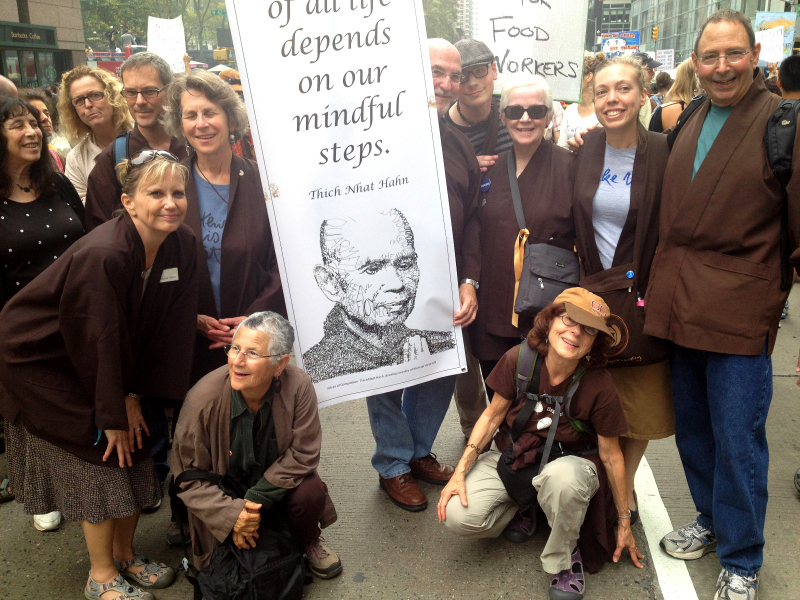 In addition, there are other areas in which we, directly or indirectly, increase the amount of greenhouse gases: emission from cooling and heating in buildings and production, transportation and industrialized food production with the livestock industry being the main culprit of greenhouse gas emission. Therefore, we can help preserve the environment by looking back at the way we consume, especially our consumption of animal products.
In addition, there are other areas in which we, directly or indirectly, increase the amount of greenhouse gases: emission from cooling and heating in buildings and production, transportation and industrialized food production with the livestock industry being the main culprit of greenhouse gas emission. Therefore, we can help preserve the environment by looking back at the way we consume, especially our consumption of animal products.
When consuming products such as meat or dairy, we should ask ourselves if we are causing the suffering of other living beings. Watching the mass media advertisements, we have the wrong perception that the eggs or steaks come from happy chickens or cows. We are fooled. We don’t know that newly born calves are immediately separated from their mothers and raised for meat. Cows are continually inseminated so they can produce milk constantly. Usually, milk cows are confined in stalls all day, unable to move. That is the worst exploitation that we can imagine. The life span of a cow raised in this way is about one third that of a cow’s natural lifespan.
Growing grains and vegetables for the livestock industry is also a waste of resources. Instead of feeding our fellow human beings suffering from starvation, we use our food to raise animals for meat. Let’s look at an example of a modern method of food production to see the stark difference with the local production. In America, grains are grown in certain areas; livestock is raised in certain areas and then transported to certain slaughterhouses. Therefore, grains, livestock and meat are transported from places to places, giving rise to “food miles.” The longer the transport, the higher the CO2 emission increases.
Besides, we also need to mention climate injustice. Lifestyle and consumption in developed countries are intricately linked to the environmental pollution and the climate crisis that we face. Meanwhile, the poorest countries, which have contributed the least and which are also the least equipped to face climate change, are the ones to bear the worst consequences.
This is clearly injustice.
Hurricanes, even when they occur in developed countries like the United States, always lead to great damages in casualties and the economy. In developed countries, even with the great post-disaster help, people still suffer greatly. When countries like the Philippines face storms, Syria faces drought, or Bangladesh faces flood, the level of suffering multiplies since these are developing nations. The number of climate refugees increases day by day.
Many species have become extinct because their natural habitats have been compromised significantly. The cycle of rain and drought also changes. The sixth mass extinction has started. Therefore, we need to recognize and be mindful that human activities, including the extraction and consumption of fossil fuel (oil, gas, and coal) are the main cause of this crisis. Fossil fuel is non-renewable. We can see that nations and big corporations are competing for natural resources all over the world. We can also see that human resources, animals, and mineral resources have been exploited without mercy to satisfy human greed.
That is why I feel that we, as a Sangha, have to be resolute in not contributing to this crisis. We need to learn to change our lifestyle and to engage in order to support a collective awakening.
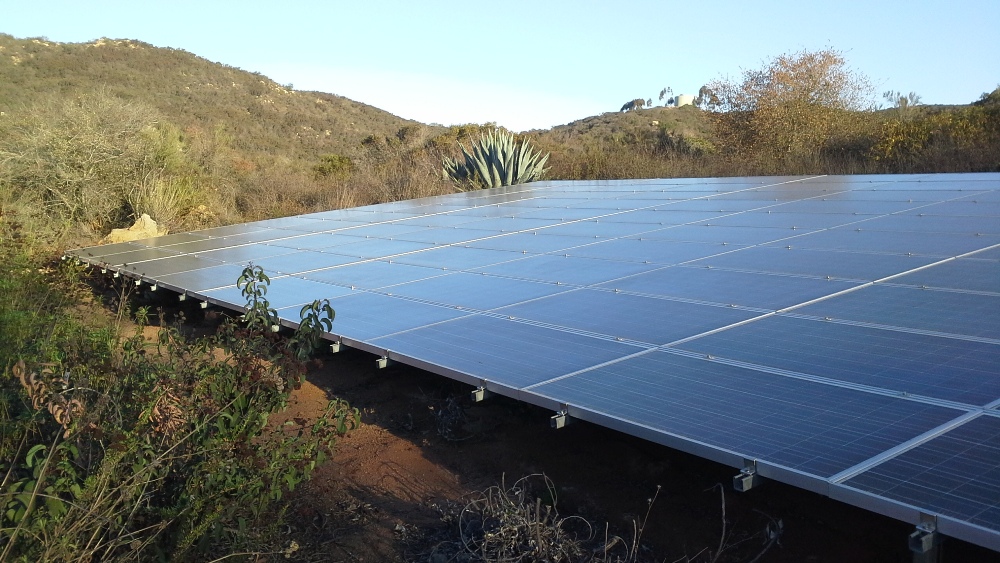
Thay gave an emphatic Dharma talk at Deer Park Monastery on how the Sangha needs to practice to consume less and make better use of renewable energy. This is not a new idea since Thay started this revolution many decades ago. In 1971, Thay and Sister Chan Khong helped to organize an environment conference in Menton, France, with the main topic of overpopulation. In the end, there were about 2000 scientists who signed the Menton treaty. In 2008, thanks to the help of the brothers, the entire Deer Park Monastery began running on solar energy.
If we are children of the Buddha, the followers of Thay, we need to look into the suffering of our time in order to find a way of practice to reduce our contribution to that suffering and to help others see this crisis clearly. I think that this is the least we can do. Had I not been struck by Thay’s engagement in many environmental and social issues that the world is facing in addition to his clear teaching and applicable practice, I would have not become a monastic in the Plum Village tradition.
The editorial board: Thank you brother.
This article was originally published in Vietnamese on langmai.org
Translation credit: Tung Bui

